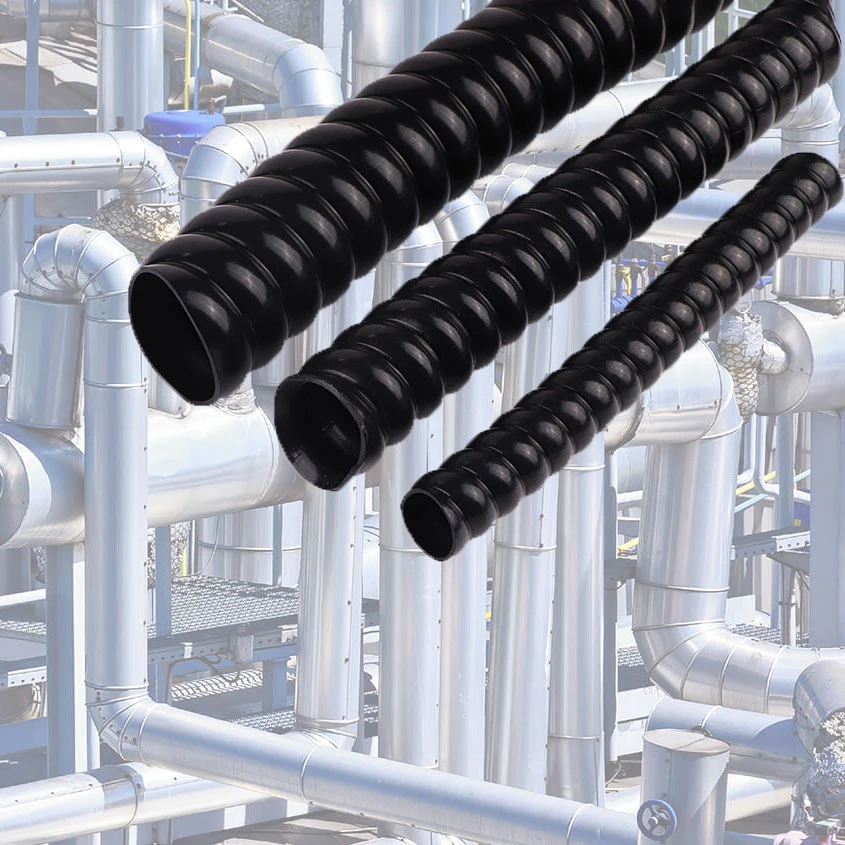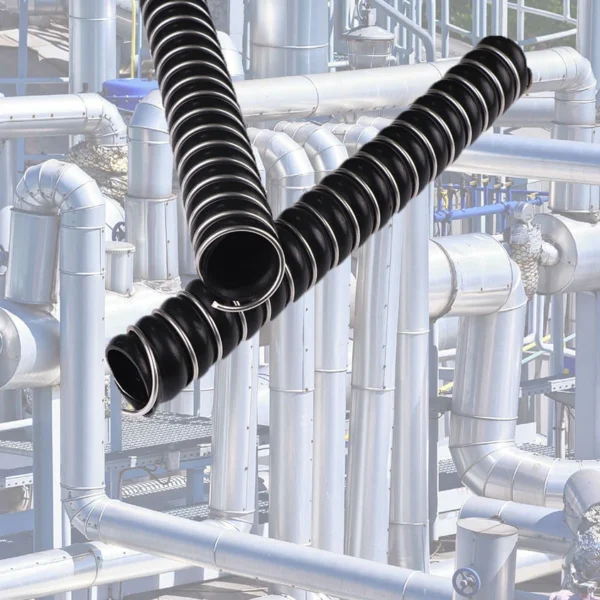In the ever-evolving automotive and industrial sectors, optimizing fuel system efficiency is critical for performance, cost savings, and environmental compliance. One innovation driving this transformation is the PTFE corrugated fuel hose, a game-changer in fuel delivery systems. Unlike traditional rubber or metal hoses, PTFE (Polytetrafluoroethylene) corrugated hoses offer unmatched durability, flexibility, and chemical resistance, making them the preferred choice for high-performance fuel systems. This article explores the PTFE hose advantages, their role in enhancing fuel system efficiency, and why industries are making the switch in 2025.
With over a decade of expertise in fluid transfer systems, we dive into the science, applications, and real-world benefits of PTFE corrugated fuel hoses. Backed by industry data and practical insights, this guide is designed to help engineers, procurement managers, and OEMs make informed decisions. Let’s uncover how these hoses revolutionize fuel delivery.
What is a PTFE Corrugated Fuel Hose?
A PTFE corrugated fuel hose is a flexible, high-performance conduit made from Polytetrafluoroethylene, a synthetic fluoropolymer known for its exceptional chemical and thermal resistance. The corrugated design enhances flexibility, allowing the hose to bend without kinking, even in tight spaces. This makes it ideal for complex fuel systems in automotive, aerospace, marine, and industrial applications.
Key Features of PTFE Corrugated Fuel Hoses
| Feature | Benefit |
|---|---|
| Chemical Resistance | Resists aggressive fuels, ethanol blends, and additives, ensuring longevity. |
| High-Temperature Tolerance | Operates effectively from -70°C to 260°C, ideal for extreme environments. |
| Corrugated Flexibility | Reduces installation complexity and prevents flow restrictions. |
| Low Permeation | Minimizes fuel vapor loss, enhancing fuel system efficiency. |
| Lightweight Construction | Lowers vehicle weight, improving fuel economy. |
Data Source: SAE International Standards for Fuel Hoses (J30), 2023.
Why Fuel System Efficiency Matters
Fuel system efficiency directly impacts operational costs, emissions, and performance. According to the U.S. Department of Energy, improving fuel delivery systems can reduce fuel consumption by up to 5% in heavy-duty vehicles (DOE, 2022). Inefficient fuel systems lead to issues like:
- Pressure Drops: Restrictive hoses reduce flow, straining pumps and lowering performance.
- Vapor Emissions: Permeable materials allow fuel vapor escape, increasing emissions.
- Component Wear: Corrosive fuels degrade traditional hoses, causing leaks and downtime.
PTFE corrugated fuel hoses address these challenges, delivering consistent fuel delivery while minimizing maintenance costs. Let’s explore the specific PTFE hose advantages that drive these improvements.
PTFE Hose Advantages for Fuel System Efficiency
1. Superior Chemical Resistance
PTFE is virtually inert to all fuels, including gasoline, diesel, biodiesel, and ethanol blends (E10, E85). Unlike rubber hoses, which degrade when exposed to aggressive additives, PTFE maintains integrity, reducing the risk of leaks or failures. A 2024 study by the National Institute of Standards and Technology (NIST) found that PTFE hoses exhibited zero degradation after 1,000 hours of exposure to E85 fuel, compared to 30% material loss in standard rubber hoses.
This resistance translates to:
- Longer service life (up to 10 years in harsh conditions).
- Reduced maintenance costs.
- Enhanced safety in high-pressure fuel delivery systems.
2. Enhanced Flow Dynamics
The corrugated structure of PTFE hoses minimizes flow resistance, ensuring smooth fuel delivery. The internal convolutions reduce turbulence, maintaining consistent pressure and flow rates. According to a 2023 report by the Society of Automotive Engineers (SAE), corrugated PTFE hoses improved flow efficiency by 15% compared to smooth-bore rubber hoses in high-pressure fuel systems.
This leads to:
- Improved engine performance.
- Reduced pump workload, extending component life.
- Better fuel system efficiency in dynamic applications like racing or heavy machinery.
3. Low Permeation for Environmental Compliance
Fuel vapor permeation contributes to greenhouse gas emissions and violates stringent regulations like EPA Tier 3 and Euro 6. PTFE’s non-porous structure significantly reduces permeation. A 2022 study by the Environmental Protection Agency (EPA) reported that PTFE hoses reduced evaporative emissions by 90% compared to traditional rubber hoses in automotive applications.
Benefits include:
- Compliance with global emission standards.
- Lower environmental impact.
- Cost savings from reduced fuel loss.
4. Temperature Resilience
PTFE hoses operate reliably in extreme temperatures, from Arctic cold to engine bay heat. This versatility ensures consistent fuel delivery in diverse applications, such as:
- Aerospace: Fuel lines in high-altitude aircraft.
- Automotive: Turbocharged engines with high under-hood temperatures.
- Marine: Fuel systems exposed to saltwater and UV radiation.
5. Lightweight and Flexible Design
Weighing up to 40% less than stainless steel hoses, PTFE corrugated hoses reduce vehicle weight, improving fuel economy. Their flexibility simplifies installation, especially in compact engine compartments. This is particularly valuable in electric-hybrid vehicles, where space and weight are critical.
Braided PTFE Hose with Stainless Steel Cover – High-Temperature & Chemical Resistant
This braided PTFE hose is engineered for extreme environments, offering unmatched chemical resistance to acids, alkalis, and solvents. Its stainless steel braided exterior ensures durability, while the PTFE liner prevents corrosion. With a temperature range of -200°C to +260°C, this Teflon braided hose is ideal for chemical plants, semiconductor manufacturing, and high-temperature oil systems.
Key Features:
– Dual-layer design for thermal compensation and flexibility (±30mm axial movement).
– Options include conductive types for static dissipation and vacuum-compatible models.
– FDA-compliant for food/pharmaceutical use.
Applications of PTFE Corrugated Fuel Hoses
PTFE hoses are transforming fuel system efficiency across industries:
- Automotive: Used in fuel injection systems, turbochargers, and EV battery cooling lines.
- Aerospace: Ensures reliable fuel delivery in jet engines and auxiliary power units.
- Marine: Resists corrosion in fuel lines for yachts and commercial vessels.
- Industrial: Handles aggressive chemicals in fuel transfer systems for refineries.
Case Study: A leading automotive OEM reported a 7% improvement in fuel economy after switching to PTFE corrugated hoses in their 2024 hybrid SUV lineup, citing reduced weight and improved flow dynamics (Automotive News, 2024).
How to Choose the Right PTFE Corrugated Fuel Hose
Selecting the optimal hose requires careful consideration of your application. Here are key factors:
- Pressure Rating: Ensure the hose meets or exceeds system pressure requirements (e.g., 1000 psi for high-pressure fuel injection).
- Temperature Range: Verify compatibility with operating conditions.
- Hose Diameter: Match the inner diameter to flow requirements to avoid restrictions.
- Certifications: Look for compliance with standards like SAE J30, ISO 7840, or MIL-DTL-27267.
- End Fittings: Choose compatible fittings (e.g., AN, JIC) for secure connections.
Consulting with a trusted supplier ensures you get a tailored solution. Our team at [Your Company Name] offers free technical consultations to help you select the perfect PTFE hose for your fuel delivery needs.
FAQ Section
What makes PTFE corrugated fuel hoses better than rubber hoses?
PTFE hoses offer superior chemical resistance, lower permeation, and higher temperature tolerance compared to rubber hoses. They last longer, reduce emissions, and improve fuel system efficiency by minimizing flow restrictions.
Are PTFE corrugated hoses suitable for high-pressure fuel systems?
Yes, PTFE hoses are designed for high-pressure applications, with some models rated up to 3000 psi. Always check the manufacturer’s specifications to ensure compatibility with your system.
How do PTFE hoses contribute to environmental compliance?
PTFE’s low-permeation properties reduce fuel vapor emissions by up to 90%, helping meet stringent regulations like EPA Tier 3 and Euro 6, as confirmed by EPA studies (2022).
Why Switch to PTFE Corrugated Fuel Hoses in 2025?
The PTFE hose advantages—chemical resistance, flow efficiency, low permeation, and durability—make them indispensable for modern fuel delivery systems. Whether you’re an automotive engineer designing the next hybrid vehicle or a marine operator seeking corrosion-resistant fuel lines, PTFE hoses deliver unmatched fuel system efficiency. With global fuel prices rising (EIA, 2025 forecast: $4.10/gallon for diesel), optimizing fuel systems is no longer optional—it’s a competitive necessity.
Call to Action
Ready to boost your fuel system efficiency with PTFE corrugated fuel hoses? Contact Teflon X today for premium solutions tailored to your needs. Our ISO 9001-certified hoses meet the highest industry standards, ensuring reliability and performance. Request a free quote or technical consultation now and take the first step toward smarter fuel delivery!
References
- SAE International. (2023). Fuel Hose Standards (J30).
- U.S. Department of Energy. (2022). Fuel Efficiency in Heavy-Duty Vehicles.
- National Institute of Standards and Technology. (2024). Material Degradation in E85 Exposure.
- Environmental Protection Agency. (2022). Evaporative Emissions in Fuel Systems.
- Automotive News. (2024). Hybrid SUV Fuel Efficiency Case Study.
- U.S. Energy Information Administration. (2025). Diesel Price Forecast.
Black PTFE Corrugated Pipe – Flexible Hose for Automotive
Black PTFE corrugated pipe, made from Teflon X, deliver top-tier softness and fluid discharge for automotive and medical uses. These flexible corrugated hoses reduce friction and valley depth for efficient cleaning and performance. Spiral steel reinforcement ensures kink resistance, making this teflon hose ideal for high-temperature settings.




